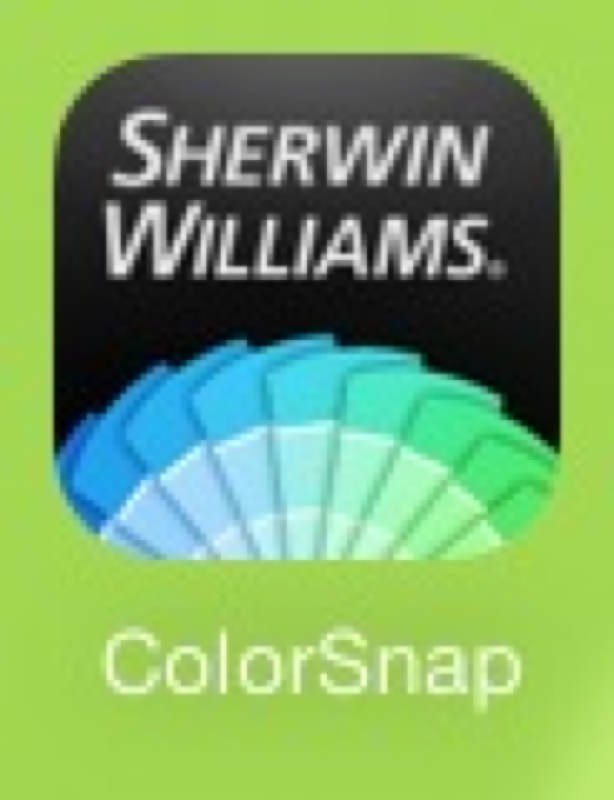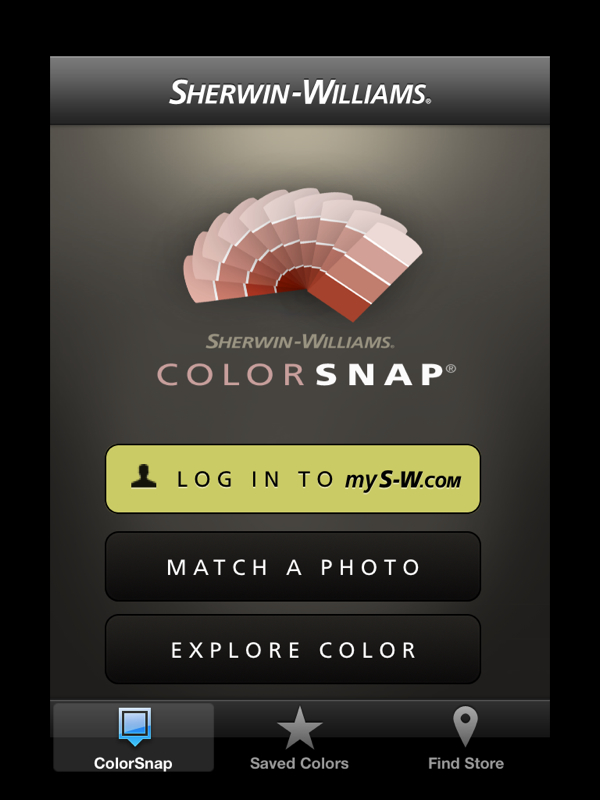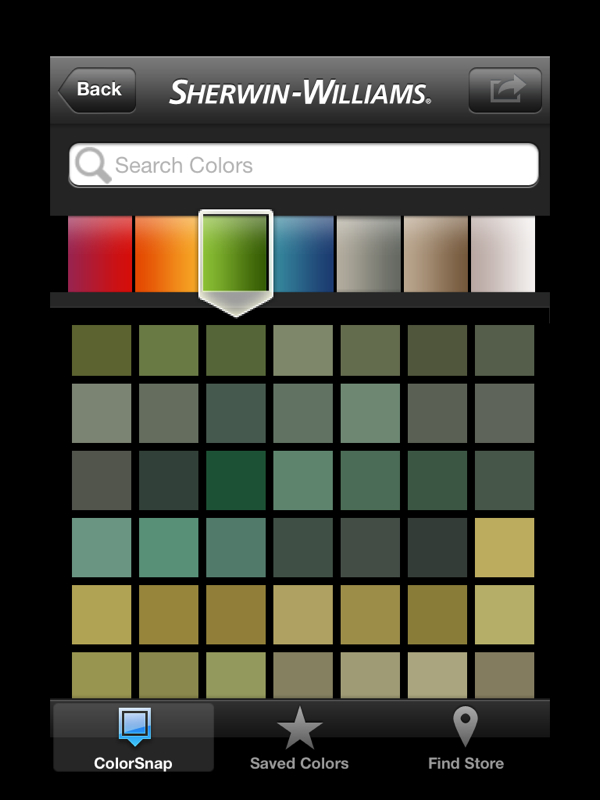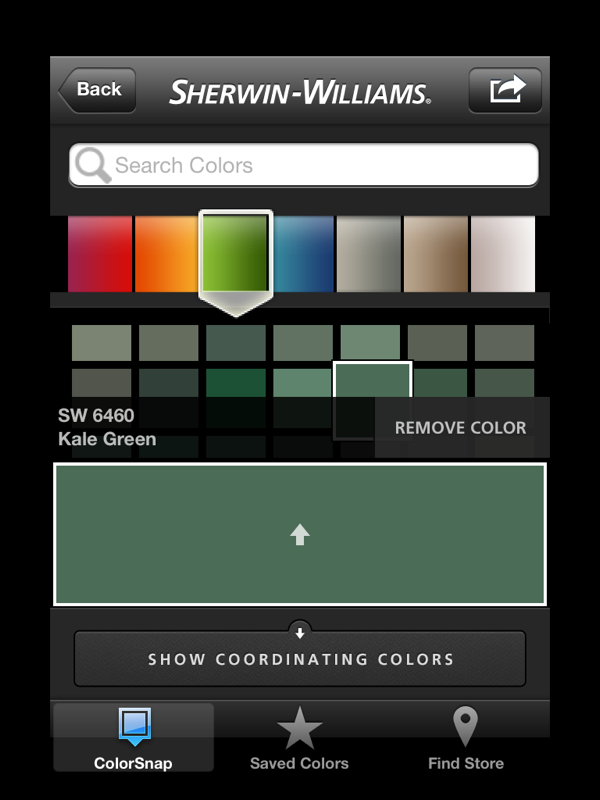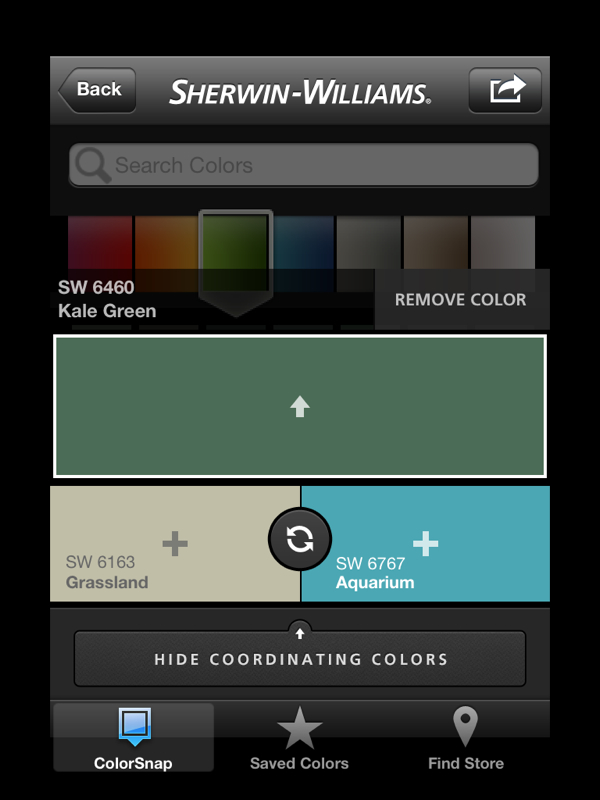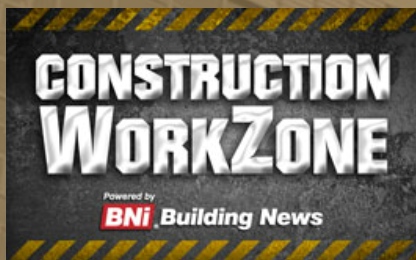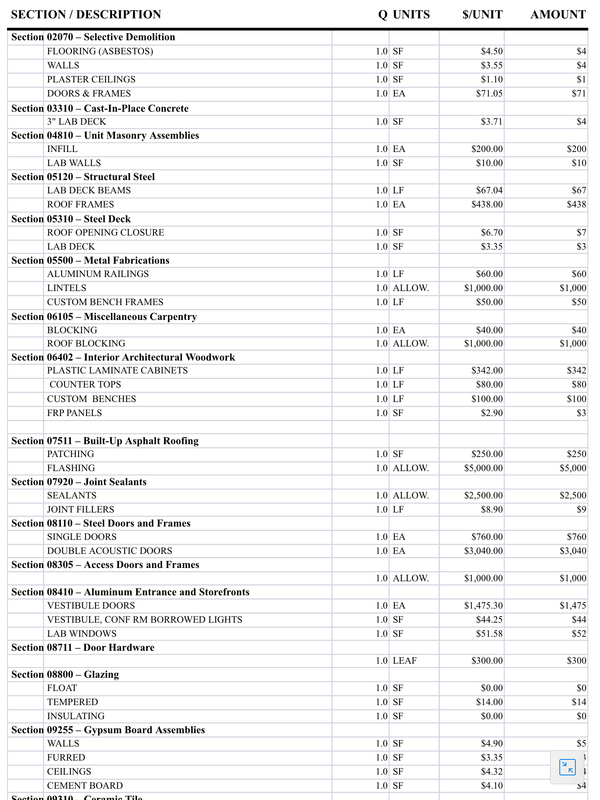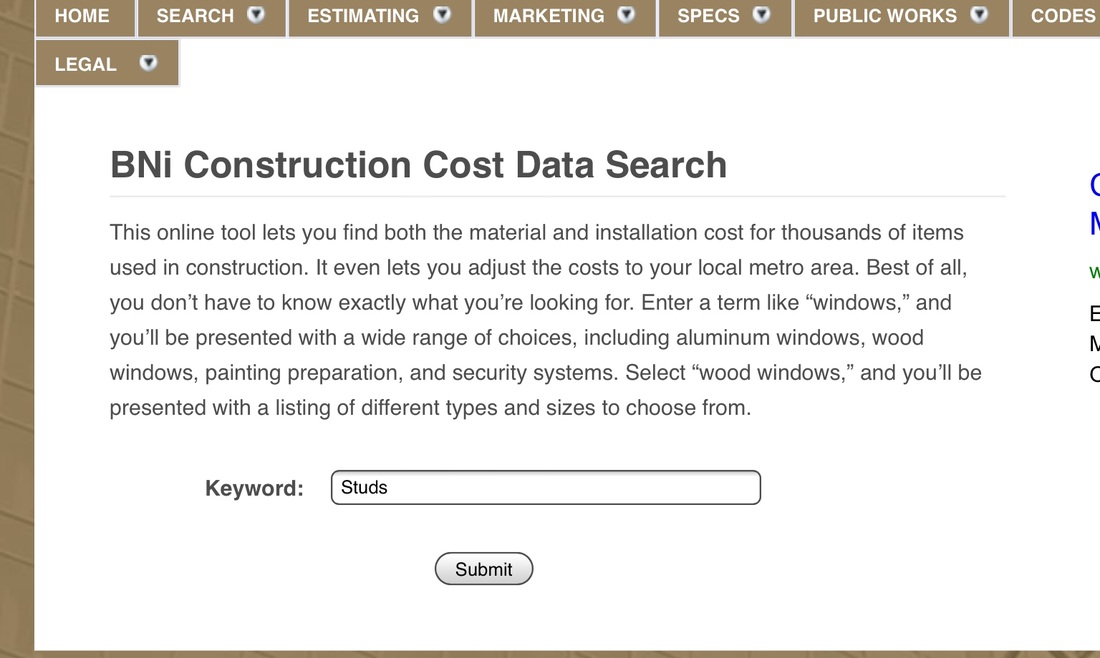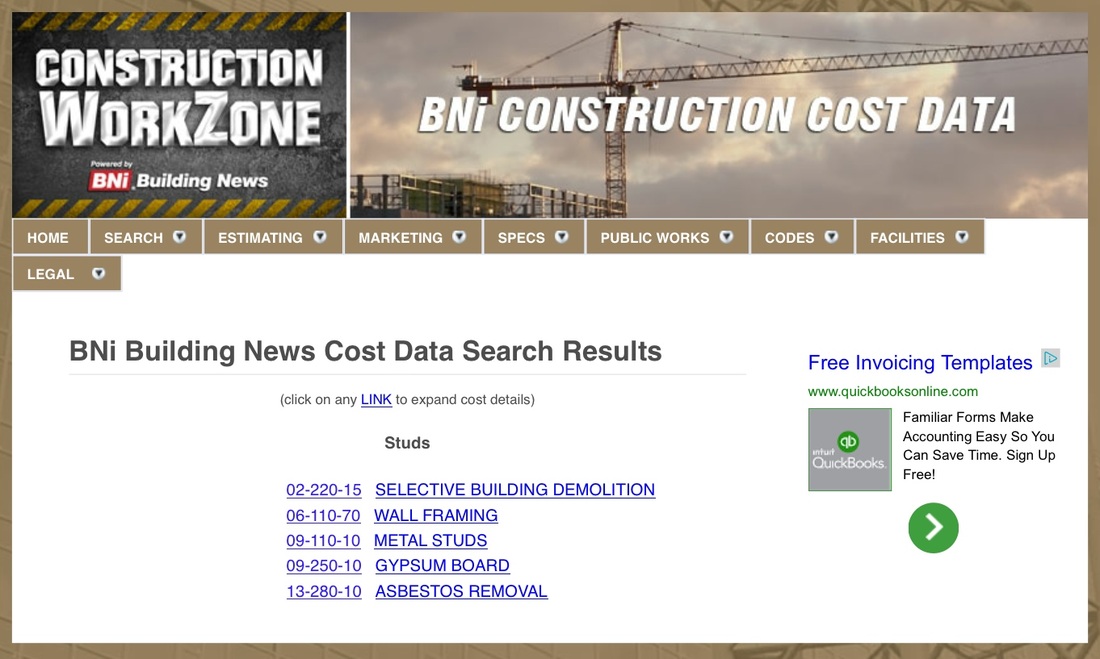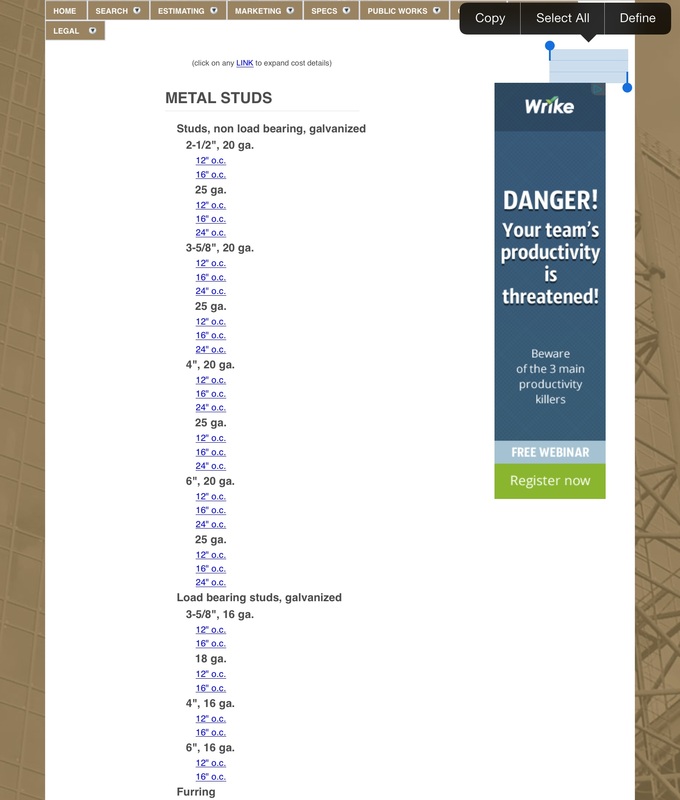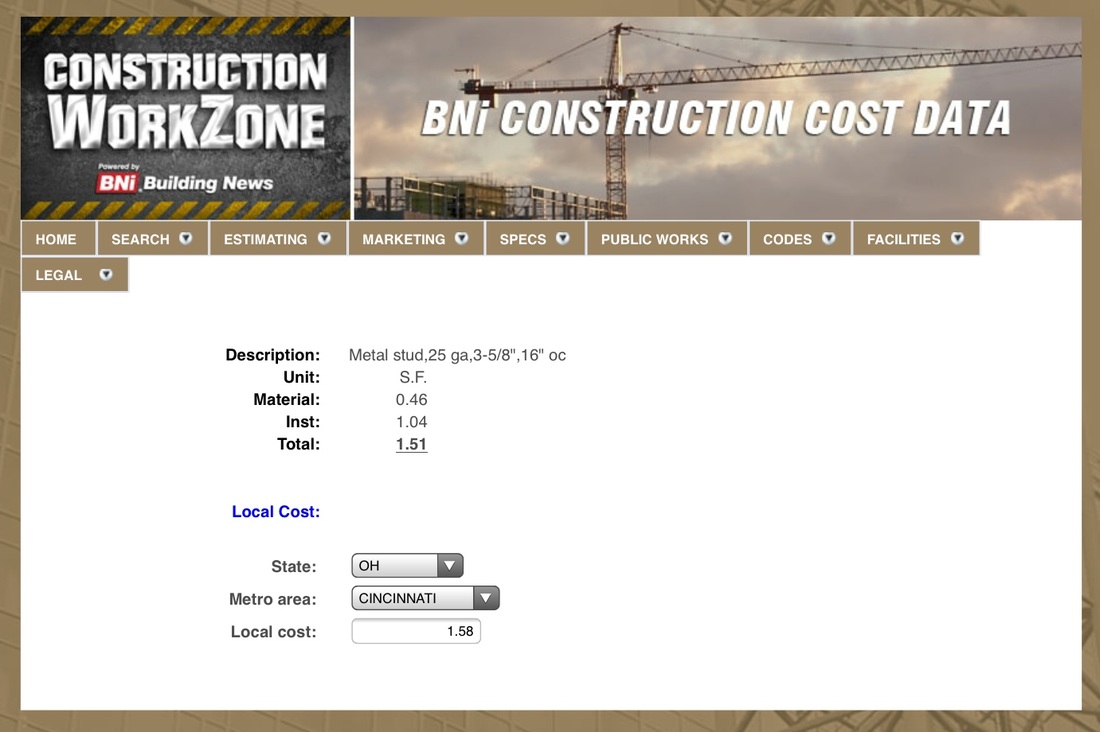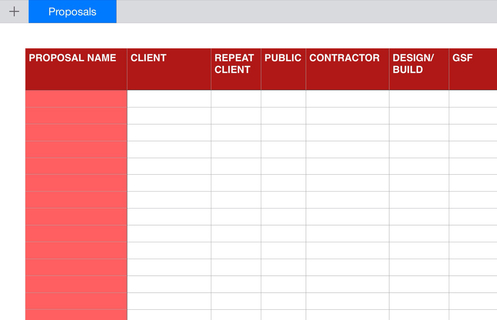TAKE A PICTURE Let's say you want to pick an accent color. Take a picture that shows the current color. Point to the color in the photo to select it. The app matches it to the closest color in the system. From there you can look at four coordinating colors. The colors seem to be two pairs, each pair containing one lighter color and one darker color. (See the bottom photos.) Select one of the colors. Done. ANOTHER METHOD Another approach, using the iPad app, after you have 'pulled' a color from your photo; you can select it to see its details. This will include a list of any 'collections' that include it. From there select 'Explore Color' and select one of the collections to see other colors that are part of the collection. The collection will contain several colors that "go with" your starting color, but not all will be great choices. Some discernment is required. FEATURES
By the way, there is an iPad app as well as an iPhone app. They are very similar but the features are more numerous on the iPad version.
Since the App is free, I suggest getting it and playing around with it to see if it is a 'keeper'.
So here is how Construction WorkZone works. Register for free to look up 10 items; or sign up for monthly use - $.99/first month, then $3.95/mo., cancel anytime. The data search looks like the screenshots below. The localized cost modifier seems to be a constant percent when I spot checked it. So you could do that just once on your subtotal. The key features of cost estimating don’t require exact unit costs, which don’t exist anyway. Just look at the bids you receive for proof. SUMMARY - PROs Low Cost Reasonably comprehensive Lots better than guessing Low learning curve SUMMARY - CONs A little more time-consuming than I would like Must transcribe costs, which is error-prone Results not saved for you (so take screenshots??) The ideal follow-through on your fee calculation efforts would be to capture all the key parameters of the fee and project. Put this data in a table for future reference when you are proposing the next fee. Strictly speaking this is not necessary, but there will be many times that you wish you had this information. Besides this table, keep a copy of your calculations in one folder for easy research when you have a similar project or client under consideration.
I recommend setting up the table as a spreadsheet. Place each fee proposal on a row and use the columns to capture the data. The spreadsheet will let you sort the proposals by any column or even filter out proposals that are not relevant. Here is a master listing of column headings you might consider, but just use the ones that pertain to your type of work.
You may never need to print this table, so don’t worry about how wide it is getting, but use ’word wrap’ and vertical column headings if you prefer. If you do need to print it, use 11x17 in landscape or your plotter. As you can see from the list, not all information that you want to have is available when you are working on the proposal. Fill in what you know right after you complete the proposal. Then update any blanks in the table the next time you work on a new proposal. Over time I think you can see just how valuable this information will be.  Image credit: David Grossman Image credit: David Grossman Every profession has terms that are specific to it. Jargon. Jargon within the profession can have a clarifying effect and can often be a shorthand for more wordy concepts. So jargon has a worthwhile effect WITHIN the profession where everyone understands what is meant. A profession’s jargon when used with the public or with clients has the opposite effect - obfuscation, confusion. It doesn't matter whether you intend to make it difficult to be understood, or if it is unintentional. The result is the same. You have chosen (intentionally or not) to rely on the authority of your role as a specialist instead of making yourself clear. I think that this comes across as arrogance. I think it is another way of saying, "Just trust me." Trust is earned, jargon gets in the way of trust. Everyone has experience with obfuscation. You are in the minority if you don't find it at least annoying. Why would you choose to NOT be understood? I can think of one or two scenarios, but they are outweighed by many more that are not very attractive. What if you think in jargon? Well, that clears up your motives for using it, but you are still left with poor communication and lack of understanding. Whenever you need agreement, jargon works against you. Even if you get the agreement, the client has an escape hatch - "I didn't know that's what we agreed to" or "I don't remember discussing that". You can tell that I am not a fan of jargon. I don't think it is just me. If it sounds better when you use jargon, I think it is because the jargon conceals the weakness of the idea(s). Do we want weak ideas? I don't. But let's go back to the trust issue. I have heard it said that there are two things you must demonstrate to win a design job - technical competence and trustworthiness that you will deliver on your promises. For many clients judging technical competence depends on past experience. Have you done this before or not? But all clients can judge trustworthiness. They do it all the time. So I think jargon lets you down in the exact scenario where you are really depending on it to make you look like a good choice. Lack of understanding (jargon) and trustworthiness travel in different circles.  Using a survey as a marketing tactic is an interesting idea I heard about from a university development director. He uses a survey to ask for prospect's help in determining what is important for the university and ends up knowing what is important to them. He then looks for opportunities to focus on what is important to them. For instance he would ask prospects to rank 8 initiatives in order of importance. (These initiatives are plans that his development department is working on.) Then months later he can use their ranking to go back to them and tell them about what was happening on that issue. And perhaps win their financial support. This approach accomplishes two important things. First, you are gaining an insight into what your prospect's interests are, which can inform your approach to them in the future. Second, you are creating a basis for interaction before a project is launched. Asking for help is a well-known tactic for building a relationship. A third benefit is that the process offers an additional opportunity to remind your prospect that you exist. My development department friend asks for an appointment and does the survey in person, taking notes. That is a very powerful way to implement this tactic. However, the time and attention this requires might not work in every case. Plan B is an electronic survey distributed by email. Survey Monkey is a free (and easy) survey tool you could use. There are others. You should keep the survey brief and state up front how many questions and how long it will take. Make it as brief as you can while still getting some useful feedback. Below is an example/sample survey. Feel free to use these questions as-is or customize to suit yourself. Each of the first four questions offer the same choices to choose from.
Example Survey
We once surveyed all of our past clients about their experience with us. The feedback caused us to make some improvements. You might consider that use of a survey, too. Or you could make it part of your project closeout. Or make it an annual event.
orig post date Dec 2012  There are four Value Propositions for any business: 1. Best quality. Richard Branson once said that being the best at something is a pretty good business model, and I agree. Think of brands that set a standard, like Louisville baseball bats, Benjamin Moore paints, and Stradivarius violins. You don't have to be a sports nut to have heard of the 125-year history of the Louisville Slugger, nor do you have to be a classical music aficionado to have heard of the legendary Stradivarius violins. Brands that set standards are sometimes luxury brands, but not necessarily. You don't need luxury to set a best-in-class standard. Brands like Benjamin Moore define quality in their categories. That's an enviable position and a value proposition that works. 2. Best bang for the buck. Recessionary woes have amplified the fact that some consumers will always buy on price. Best-in-class value doesn't always mean lowest price, however, but rather the best quality-to-price ratio. Jet Blue is a good example of a company that, though it may not offer the cheapest or best in comfort travel, does a good job of communicating its value relative to its price point. Dell, Chipotle, Ikea, and Toyota are other good examples of best-in-class value, and their value propositions have been sustainable through the years. Incidentally, the founder of Ikea, Ingvar Kamprad, has regularly traded places with Bill Gates on various world's richest lists. 3. Luxury and aspiration. On the other end of the spectrum from bang-for-buck players are luxury providers that promise the experience of a wealthy lifestyle to aspirational consumers. Ralph Lauren is one of the masters of a lifestyle luxury brand; others are Rolex, BMW, and Hermes. While the luxury segment was hurt during the downturn, it is almost certain that as the economy rebounds that customers will return to luxury goods as their discretionary spending increases. 4. Must-have. One of the most attractive value propositions we have seen and studied are the "must-haves." These include basic goods — certain foods, for instance. During my prior work with Thomson Reuters, we often talked about "must-have" content that business professionals could not do their jobs without. The critical legal information and tools WestLaw provides to lawyers are an example. As long as there are legal cases, there will be a need for legal information. It does not mean there will not be competition, but if the category you are pursuing is must-have, then the market leaders will have a great prize to share. Lifted from an article titled "Value Propositions That Work", by Anthony Tjan on the HBR Blog Network.
orig post date OCT 2012 |
x
Archives
February 2024
Categories
All
|
Architekwiki | Architect's Resource | Greater Cincinnati
© 2012-2022 Architekwiki
© 2012-2022 Architekwiki
